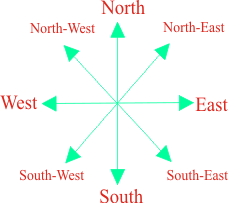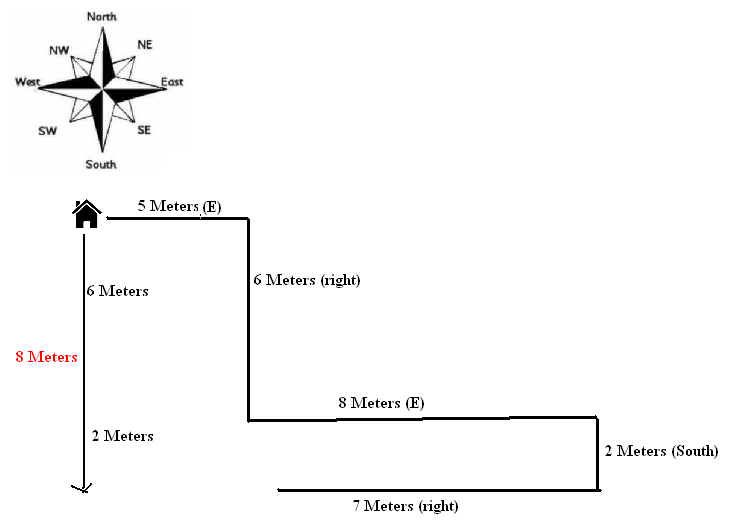Verbal Reasoning Shortcuts - Direction Sence
Now a days in almost all competitive exams you get questions which test your sense of direction in verbal reasoning section. These questions typically involve a person's moving certain distances in specified directions. Then, the student is asked to find out the net distance traveled between two points. The easiest way of solving these problems is to draw a diagram as you read information about the problem and let the diagram reflect all the information given in the problem.

The distance from a particular point after traveling a distance of X meters in the horizontal direction and a distance of Y meters in the vertical direction is equal to X2+y2 (Please note that in common usage, north-south direction is referred to as "vertical" direction and east-west direction is referred to as "horizontal direction.
To solve these types of problems, the student should know the directions properly - without any confusion. The following diagram shows all the directions and the student should memorize the diagram.
If you have problems in remembering the above diagram then just remember the word NEWS and a reverse S. Of course, this S is not like your Normal S. Its kinda kiddish. Have a look at the below figure.
Start with N (for North) and move to E, W and finally S. Mark the corner of North and East as North-East, South and East as South-East and so on... Well, you have your own diagram now :P
Now lets have discuss this topic with some examples. So that you can easily understand what exactly is Direction Sense and how to solve the problems.
1. A person travels towards east from his house and travels a distance of 3 meters; he then travels a distance of 7 meters south wards and then travels towards east a distance of 3 meters and finally travels southwards a distance of 10 meters. What is his vertical distance from his house?
Solution :
The distance traveled by him is equal, to 10 + 7 = 17m. Have a look at the below figure for detailed understanding.
2. A person starts from his house and travels 5 meters towards east, then travels 6 metres towards right, then travels 8 meters towards east and travels 2 meters towards south after that. Finally he turns right and travels 7 meters. What is the total distance he has traveled from his house in the north-south direction?
Sol : The distance he traveled from his house in north-south direction is equal to 6 + 2 = 8 Meters.
3. A person travels 7 meters towards east, then he turns right and travels 2 meters; then travels 5 meters towards left and then proceeds 2 meters northwards and finally travels 2 meters westwards. How far is he from his house in the vertical direction?
Sol : The distance covered by the person in the north-south direction from his house is equal to 2-2 = 0 meters (Here please keep in mind that he has actually traveled 2+2 = 4 meters in the north-south direction but, of that distance, since 2m is towards north and 2m towards south, effectively, he is 0m away from his house in the north-south direction).
4. Starting from one location, a person travels a distance of 5 meters southwards, then travels a distance of 7 meters leftwards, then travels 5 meters northwards and finally travels 6 meters eastward to reach a new location. What is the distance he travelled from his previous location?
Sol : The distance traveled by vertically is 5-5 = 0 meters and the distance travelled horizontally is equal to 7+6 = 13m. Therefore, the distance travelled from his original location is also equal to 13m.
 5. A person starts from his house and goes 2 meters towards east, then turns towards right and goes 25 meters and again goes towards east traveling 15 meters and then turns left and travels for 18 meters. He then goes towards east and travels 7 meters. How far is he from his house?
5. A person starts from his house and goes 2 meters towards east, then turns towards right and goes 25 meters and again goes towards east traveling 15 meters and then turns left and travels for 18 meters. He then goes towards east and travels 7 meters. How far is he from his house?
Sol : If we represent the path covered by him in a diagram, it will appear as follows.
The total distance travelled horizontally is equal to 2+15+7 = 24 metres and the total distance travelled vertically is 25-18 = 7 metres.
So, the total distance travelled will be equal to root (242 + 72 ) = 25m
Now a days in almost all competitive exams you get questions which test your sense of direction in verbal reasoning section. These questions typically involve a person's moving certain distances in specified directions. Then, the student is asked to find out the net distance traveled between two points. The easiest way of solving these problems is to draw a diagram as you read information about the problem and let the diagram reflect all the information given in the problem.

The distance from a particular point after traveling a distance of X meters in the horizontal direction and a distance of Y meters in the vertical direction is equal to X2+y2 (Please note that in common usage, north-south direction is referred to as "vertical" direction and east-west direction is referred to as "horizontal direction.
To solve these types of problems, the student should know the directions properly - without any confusion. The following diagram shows all the directions and the student should memorize the diagram.
If you have problems in remembering the above diagram then just remember the word NEWS and a reverse S. Of course, this S is not like your Normal S. Its kinda kiddish. Have a look at the below figure.
Start with N (for North) and move to E, W and finally S. Mark the corner of North and East as North-East, South and East as South-East and so on... Well, you have your own diagram now :P
Now lets have discuss this topic with some examples. So that you can easily understand what exactly is Direction Sense and how to solve the problems.
1. A person travels towards east from his house and travels a distance of 3 meters; he then travels a distance of 7 meters south wards and then travels towards east a distance of 3 meters and finally travels southwards a distance of 10 meters. What is his vertical distance from his house?
Solution :
The distance traveled by him is equal, to 10 + 7 = 17m. Have a look at the below figure for detailed understanding.
2. A person starts from his house and travels 5 meters towards east, then travels 6 metres towards right, then travels 8 meters towards east and travels 2 meters towards south after that. Finally he turns right and travels 7 meters. What is the total distance he has traveled from his house in the north-south direction?
Sol : The distance he traveled from his house in north-south direction is equal to 6 + 2 = 8 Meters.
3. A person travels 7 meters towards east, then he turns right and travels 2 meters; then travels 5 meters towards left and then proceeds 2 meters northwards and finally travels 2 meters westwards. How far is he from his house in the vertical direction?
Sol : The distance covered by the person in the north-south direction from his house is equal to 2-2 = 0 meters (Here please keep in mind that he has actually traveled 2+2 = 4 meters in the north-south direction but, of that distance, since 2m is towards north and 2m towards south, effectively, he is 0m away from his house in the north-south direction).
4. Starting from one location, a person travels a distance of 5 meters southwards, then travels a distance of 7 meters leftwards, then travels 5 meters northwards and finally travels 6 meters eastward to reach a new location. What is the distance he travelled from his previous location?
Sol : The distance traveled by vertically is 5-5 = 0 meters and the distance travelled horizontally is equal to 7+6 = 13m. Therefore, the distance travelled from his original location is also equal to 13m.
 5. A person starts from his house and goes 2 meters towards east, then turns towards right and goes 25 meters and again goes towards east traveling 15 meters and then turns left and travels for 18 meters. He then goes towards east and travels 7 meters. How far is he from his house?
5. A person starts from his house and goes 2 meters towards east, then turns towards right and goes 25 meters and again goes towards east traveling 15 meters and then turns left and travels for 18 meters. He then goes towards east and travels 7 meters. How far is he from his house?Sol : If we represent the path covered by him in a diagram, it will appear as follows.
The total distance travelled horizontally is equal to 2+15+7 = 24 metres and the total distance travelled vertically is 25-18 = 7 metres.
So, the total distance travelled will be equal to root (242 + 72 ) = 25m












0 comments:
Post a Comment